Neuroscience; week 9; clinical trials and drug discovery
What is a clinical trial?
Clinical trials are medical research studies involving people
They can be used for many different reasons:
Prevent disease and reduce the number of people who become ill
Treat illness and improve or increase the number of people cured
Improve the quality of life for people living with illness –
reducing symptoms or side effects
For disease diagnosis and health problems
Not always about new medicines but could ‘interventions’ to modify lifestyle or behaviour
A brief history of clinical trials:
Evidence of clinical trials been known for centuries
Recorded in the ‘’Book of Daniel’’ in The Bible
King Nebuchadnezzar ordered his people to
eat only meat and drink only wine – to keep them strong
Several young men of royal blood objected as they only ate vegetables
The king allowed them to eat legumes (beans, peas, chickpeas, lentils) and water for only 10 days
After this point the vegetarians appeared better nourished than the meat eaters
Although not a clinical trial first example of human experiment guiding a decision about public health
1747 Scurvy trial by James Lind
First clinical trial in the modern era
Scurvy was a terrible disease that effected sailors on ships.
Lind thought it was related to diet.
He had 12 sailors with scurvy and treated them with separate food supplements
The two sailors who had oranges and lemons recovered very quickly and a third who had cider was the next best.
Wrote ‘’Treatis on Scurvy’’ published in 1753 : Not only first description of a controlled trial but also a systematic review of previous literature on scurvy.
It took the British Navy 50 years to adopt these findings in full!
Edward Jenner 1700’s side stepped the process:
Jenner was a rural GP in England – for years he had been taking notes and making observations from his local patient population.
He noticed that all the milk maids on the farms did not contract the deadly small pox disease. However all milk maids reported that they had all previously caught a similar disease called cow pox – which was allot milder with no lasting effects
In May of 1796 – Jenner performed the first ever experimental vaccination on an 8 year old boy called James Phipps. He had escaped small pox so far, Jenna infected him with cow pox then exposed him to small pox
The experiment worked : If this was done today, the scientist would face jail, However, it is argued this experiment led to Modern vaccination which has saved the most human lives in the history of science
However when Jenner presented his findings he was rejected and told to collect a larger sample data set. Which he did including his own son.
Finally published : Inquiry into the Causes and Effects of Variolae
Vaccinae (1798)
But the finding was still wildly ridiculed in society especially among religious groups
Vaccination needed robust testing
It was only in the 1800’s that several major hospitals across Europe started to do studies (‘clinical trials’) that Jenner’s vaccination method could be robustly assessed
This led to the development of modern vaccination we see today and also laid down the foundations for the rigorous clinical trials we see around the world.
Jenner’s legacy was huge (think of polio, AID’s, MMR all the way up to COVID19)
He did give James Phipps a house!
A brief history of clinical trials: Placebo
Into the 1800’s first emergence of a really important term
Plecebo
First defined in the early 1800’s
Hoopers Medical Dictionary of 1811
‘’An epithet given to any medicine more to please than the benefit of the patient’’
1863 : USA Medic Austin Flint first used a placebo in a clinical study
He gave a ‘pleceboic remedy’ for rheumatism to patients – all reported positive effects
Even though the remedy did nothing to treat the disease.
1943:
1943 : The First double blind controlled trial – Patulin (related to penecillin for common cold)
Carried out by the Medical Research Council
Recruited over a 1000 subjects from British offices and factory workers suffering from the common cold – difficult in wartime
Both the Dr’s and patients were blinded to the treatment
Unfortunately the results failed to show and effect
1946
1946 : First Randomised curative trial – using Streptomycin to treat tuberculosis
Again carried out by the MRC
Patients had systematic and randomised enrolment rather than alternating as used in previous studies into treatment and control groups.
Dr’s looking at the x-ray results were blinded to the different patient groups.
This study set the ground work for the basis of clinical trials we see today.
This included the establishment of national and international regulatory frameworks across the globe.
Why are clinical trials important?
Health professional need evidence for the best way to compare different approaches
Without clinical trials:
Patients cold be given medicines that do not work
Wasting resources
Medicine could even make the patient worse
Who is in control of the clinical trial process?
Generally designed by doctors and other specialists but involve a wide variety of people:
Doctors, nurses, patients, statisticians, trial managers and representatives from pharmaceutical companies to design the best possible trial
Designed to offer the least risk to the patient but maximum potential new treatment or intervention being tested.
Generally start with a systematic review of previous trials performed in the same area of disease of using similar drugs – To assess firstly whether this research has already been done – therefore no need for the trial.
Based on all of this information all the involved parties get together and design the trials protocol
This will then go onto the next stage …
Gaining ethical approval
The trial protocol is then sent to a research ethics committee
Independent group of people that includes doctors, nurses, other medical
Staff, members of the public and sometimes lawyers
They decide whether the trial is ethical:
They will focus on:
Do the potential benefits of the treatment/intervention out way the costs
That information provided to the participants who may take part in the trial is clear and satisfactory
That will people will be approached in an appropriate way
Is compensation in place for patients if something goes wrong
Travel expenses – are they in place
The trial can only start once ethical approval is in place
The Clinical trial also needs a sponsor
In the context of NHS research:
Sponsor: Individual, company, institution or group of organisations that takes on responsibility for initiation, management and financing of the research.
All research falling under the remit of Secretary of State for Heath must have a formal sponsor.
Sponsorship of involving medicines
It is a legal requirement for any clinical trial of an investigational medicinal product (CTIMP) to be sponsored. This includes provision for insurance in case things go wrong.
Clinical trials can be split into 4 distinct phases
Phase 1 : Early Stage – Generally small groups of healthy subjects but sometimes patients – Used to test how safe the treatment is are there any large side effects
Phase 2 : By this stage allot more is known about the treatment
This will now be tested in a larger group of people to asses safety and side effects in greater detail
For the first time to see if the treatment has a positive effect in patients
Phase 3 : Moves up to hundreds if not 1000s of people often international groups of people
Compare the new drug to a standard treatment
How well drug works and how long the effects last for
Finds out more about any serious side effects and how long they last for.
Phase 4 : The drug is now licensed and being used as a treatment
Gets stats on how well the drug is working on a large population
Any long term risks and benefits
Rare side effects.
Controlled trials
Designed to compare different treatments
Usually two groups – trials group – given new treatment
Control group given standard treatment –
Where no standard treatment - the control group may not be given any treatment or may be given a placebo
What happens during a trial?
As well as test to assess whether the treatment is working the researchers will also assess
Any potential side effects
Any new symptoms
Wider effects of treatment such as quality of life, day to day activities
Your mental state is the treatment making you happy, sad, anxious or depressed?
Cost effectiveness of treatment – are you able to work, how often you need to visit the doctor
What happens at the end of a trial?
Normally trials can last for many years (although as can be seen with COVID19 the process can be dramatically speeded up)
All participants will have access to the results of the trial if they want them.
They will also be published to help other researchers in the field and allow advancements to be taken up by everyone
In some instances the treatment used as part of the trial may not be available on the NHS – at the end of the trial you will be given the standard treatment.
In some cases you may be able to buy the new treatment
All you information will be kept confidential : a key requirement of the trials process.
What happens if something goes wrong in the clinical trial?
Before the start of any trial arrangements need to be put in place in case something goes wrong an people are harmed
Ethics committees can refuse permission if this is not in place
Important for participants to know that insurance is in place before the trial starts.
Thalidomide: 1960s
One of the darkest episodes in pharmaceutical research history
The drug was marketed as a mild sleeping pill safe even for pregnant women in the late 1950’s
As it seemed to reduce morning sickness, may pregnant women took it
However, it caused thousands of babies worldwide to be born with malformed limbs.
During the testing process on animals – no tests were included to look at the effects on pregnancy.
The damage was revealed in 1962 – before then every new drug was seen as beneficial
However, Thalidamide has been shown to reduce the symptoms of leprosy and is still being used to treat the condition.
In the USA : the boss of the Federal Drug Administration - Frances Kelsey – despite huge pressure from the pharmaceutical industry refused a license – John F Kennedy praised her as a national heroine.
Cost and success rate of clinical trials
Clinical trials are expensive
It was calculated that the average cost of a 5.5 year (non-pharmacological) clinical trial involving collecting data across 20 centres in the UK (stage 2 or 3) would cost on average ~£1M to administer:
Staff needed were the highest costs, including :
Managers
Researchers
Statisticians
~30% costs for non-staffing expenses such as ethical approval
In the UK the actual price of taking a drug from development to the market is £1.1 Billion
Only one in 10 drugs make it through to stage 4 in clinical trials …
Partially explains why drugs that developed are so expensive because the companies have so many failures.
Drug discovery
Inextricably linked to clinical trials is another process called
Drug Discovery - this aspect is just as expensive as the clinical trials that follow them and also has a high failure rate.
This process of going from drug discovery to developing a new medicine has been termed the valley of death …
The valley of death
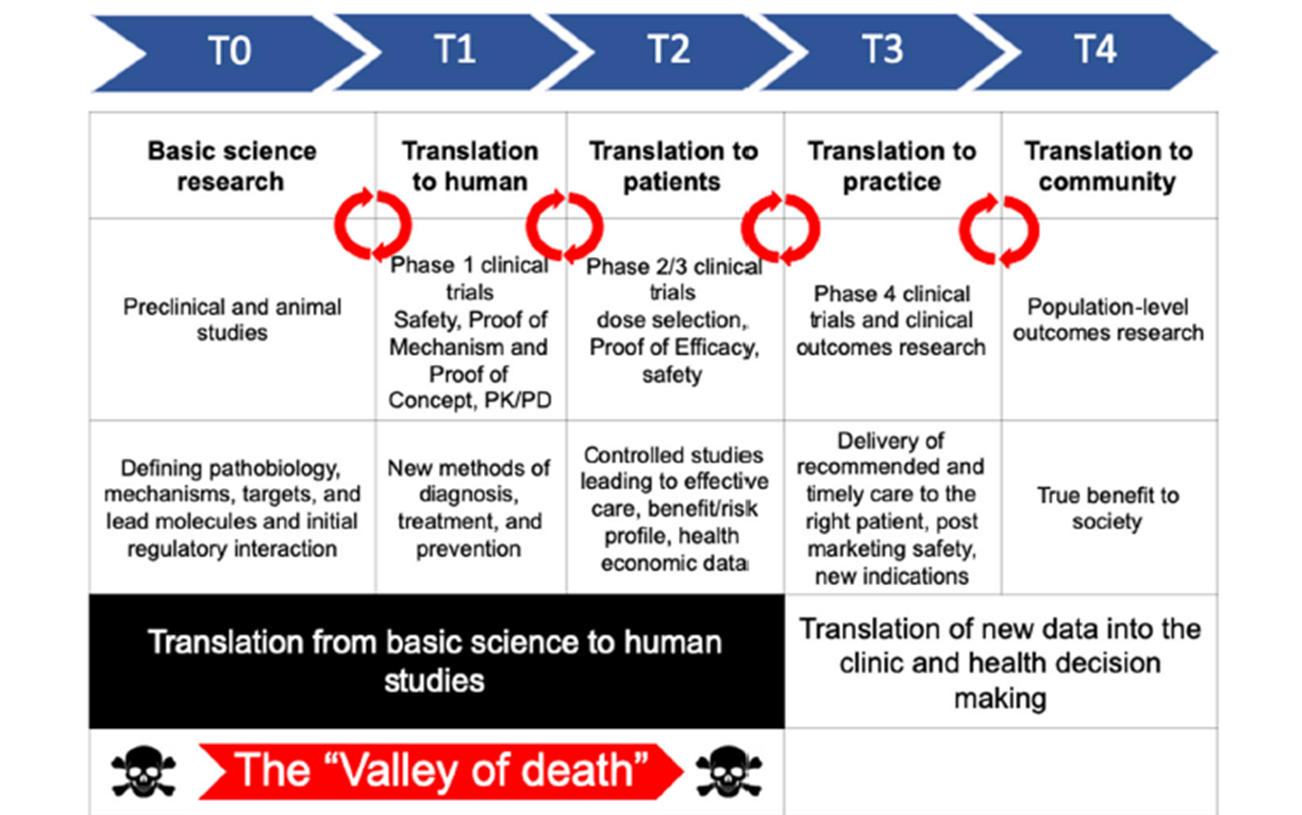
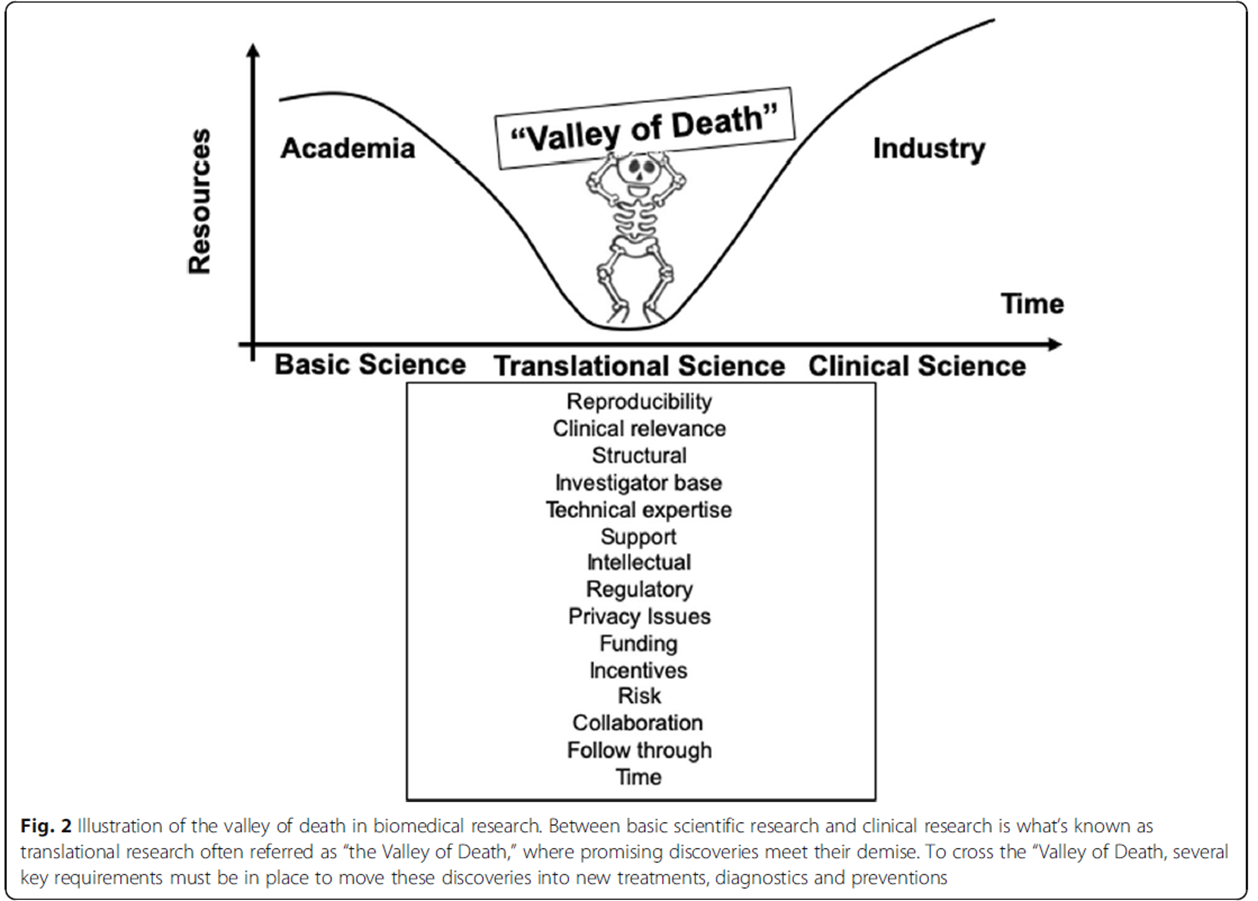
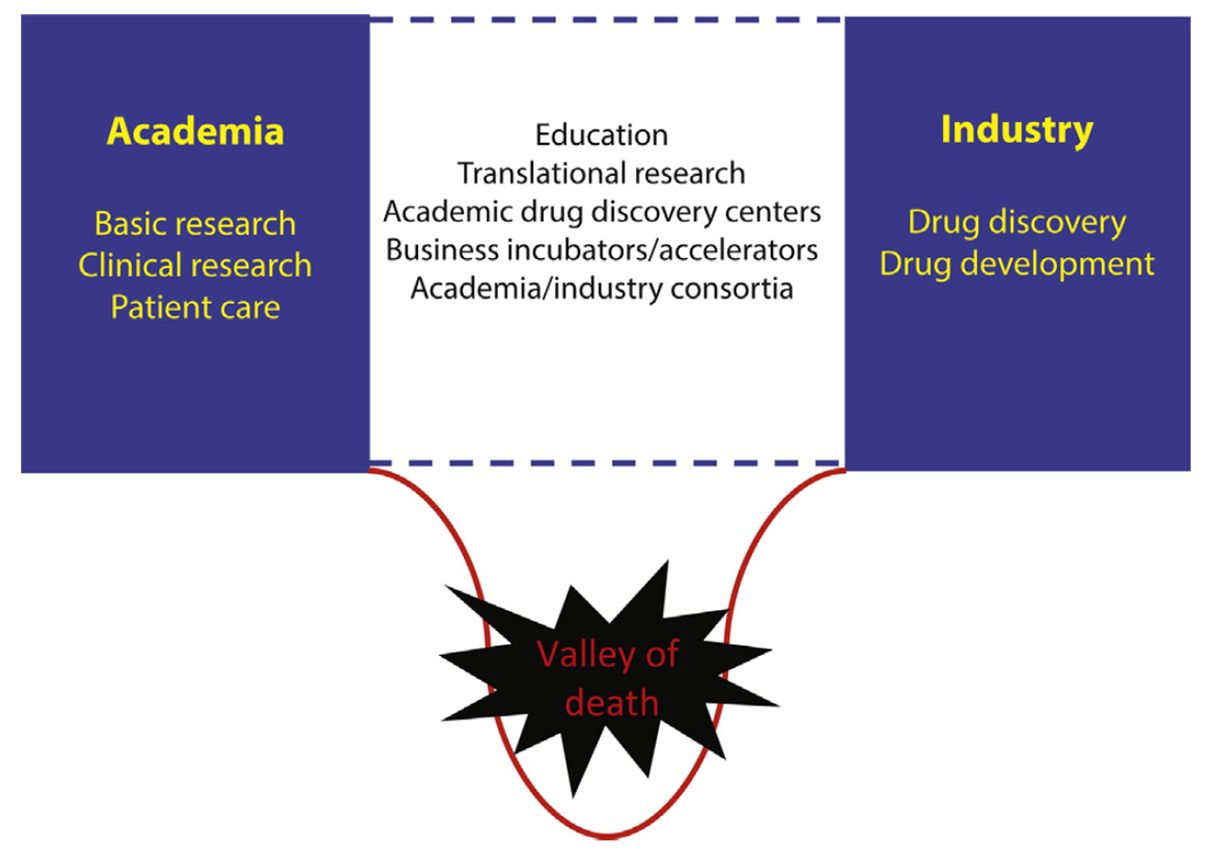
Steps in the drug discovery process
Typically researchers discover new drugs through
New insights into a disease process that allow researchers to design a product to stop or reverse the effects of a disease
Many tests or screening of compounds to find the possible beneficial effects against any of a large number of disease
Existing treatments that have an unexpected effect against a new disease (often called re-purposing or orphan drugs - could be a quick route to the clinic as often these drugs have been safely tested already) – this is true for potential treatments of COVID19 – vaccines methods that are already proved to be safe.
New technologies, such as those that provide new ways to target the medicine to specifics sites within the body – ie across the blood brain barrier
At this stage thousands of compounds my be potential candidates for development.
After early testing only a small number of compounds will look promising and call for further study
Example of a method of drug screening
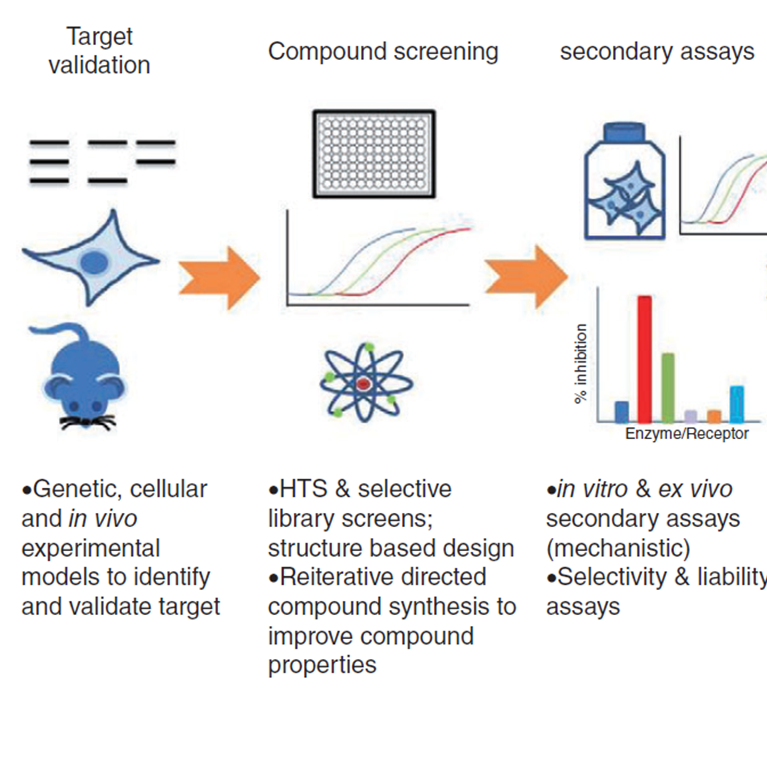
Once researchers identify a promising compound for development, they conduct experiments to gather information on:
How it is absorbed, distributed, metabolised and excreted
Its potential benefits and mechanisms of action
The best dosage
The best way to give the drug (such as by mouth or injection)
How toxic is the drug
How it interacts with other drug and treatments
How it compares to existing drugs
Development: In Vitro and in vivo testing
Before testing the drug in people, researchers must find out whether it has the potential to cause serious harm, also called toxicity
Two types of pre-clinical research are
In vitro – often looking at how cells in a test tube are effected by the treatment
In vivo- often involving small animals usually mice, but for some studies especially brain diseases, non-human primates may be used in the later stages
There are strict guidelines for pre-clinical laboratories to adhere to often referred to as Good Laboratory Practices (GLP)
GLP aims to standardise approaches and method
Good laboratory practice important
GLP sets minimum basic requirements for
Study conduct
Personnel – training of staff
Facilities
Equipment – safe and rigorously checked
Written protocols for all experiments
Standard operating procedures – minimising experimenter error
Clearly writing study reports
Quality assurance oversite for each program of work - essentially ethical approval
Usually, pre-clinical studies are not very large. However, these studies must provide detailed information on dosing and toxicity levels. After pre-clinical testing, researchers review their findings and decide whether to proceed to clinical trials.
Why do clinical studies fail? Example from stroke research
Accurate and repeatable strokes can be caused in rodents.
However as systematic review of the literature showed that
Over 800 drugs have been tested on animal models
500 of these work in reducing the effects of the stroke
100 went to clinical trials
Only one drug has become a treatment!
Researchers who randomised and blinding the experiments had less favourable results
Of 100 studies looked at in a separate study only 36% were randomised and 11% were blinded ---- these are routine in clinical trials
Why do clinical studies fail? Example from Alzheimer’s
Despite billions of pounds in investment – no disease modifying Alzheimer's drug has been developed
Many clinical trials have failed, why?
Could be the wrong target – most studies focus on Beta Amyloid plaques – it could be something else – e.g. the blood supply
Interventions might be to late - the damage is already done
Early biomarkers needed – existing treatments could be re-examined
Clinical trials often less than 5 years – for Alzheimer's this might not be long enough – however a longer trial is far more expensive
Not easy problems to solve.
Large co-hort human studies may help especially in early biomarker detection
Co-hort studies
There are many large co-hort studies underway one of the largest is
ALZHEIMERS DISEASE NEUROIMAGING INITIATIVE (USA)

Budget so far $218M : multi-modal data from elderly controls and AD patients. Tests include:
Detailed history of each patient and assessment of health and education
Neuropsychological tests
Genetic testing for risk factors :APOE4
Lumbar puncture :CSF measurement
MRI both structural and function scans
PET for glucose consumption, Tau and Beta Amyloid
Post mortem histology
BUT is this approach working?
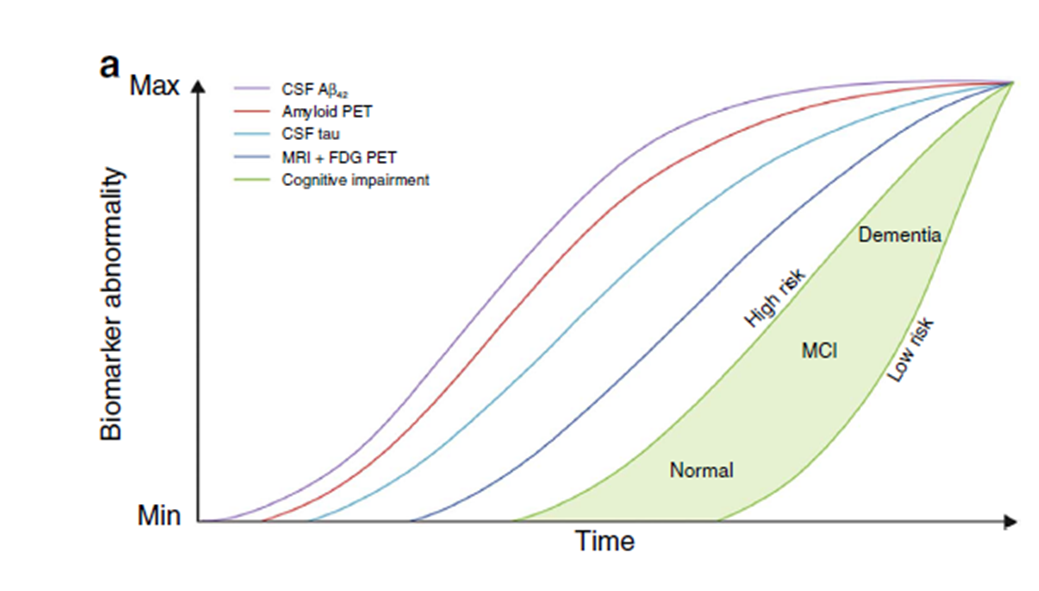
This theoretical figure is what should be produced by all the ADNI studies a complete time line of disease progression and potential to detect early biomarkers and critical time points for intervention
Currently 3393 papers have been published from ADNI studies and it keeps growing
Now moving from theoretical to measured responses
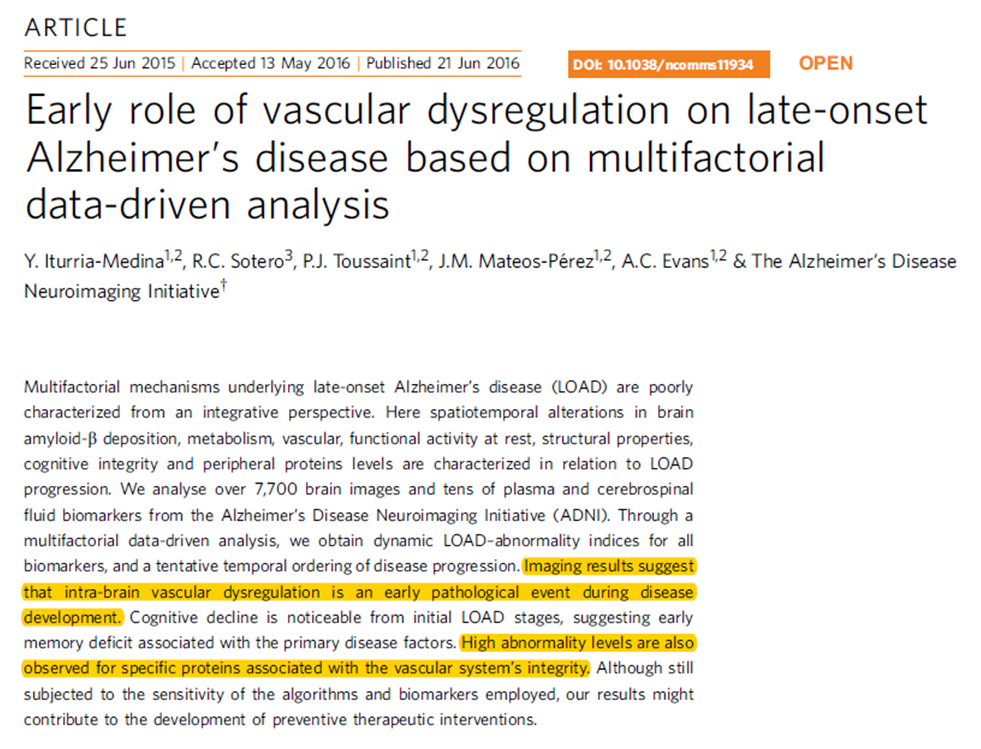

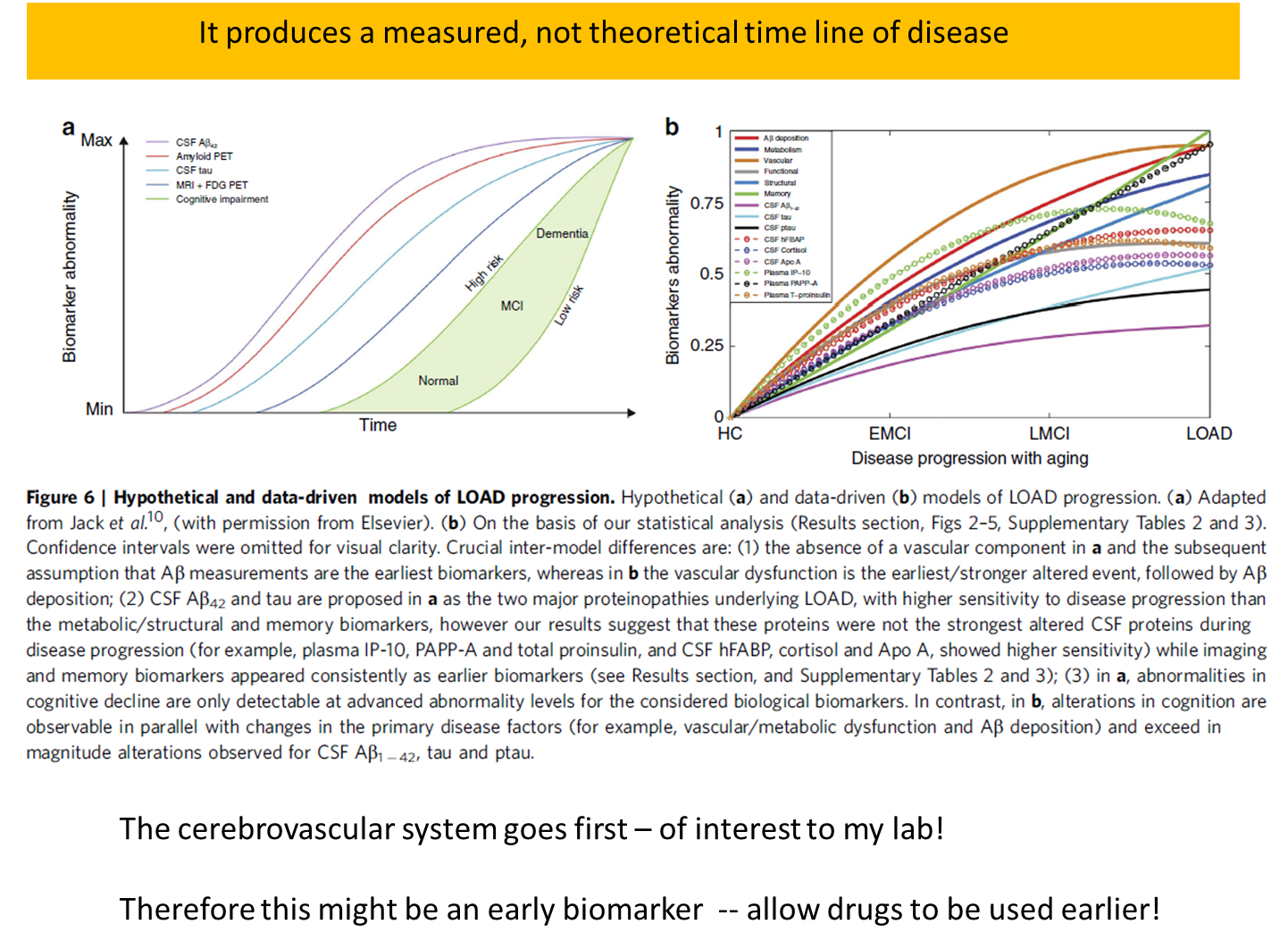
Clinical trials in the future
All about increasing the efficiency of all the steps in the process - even if only a small increase in each step- will save millions and importantly will save time
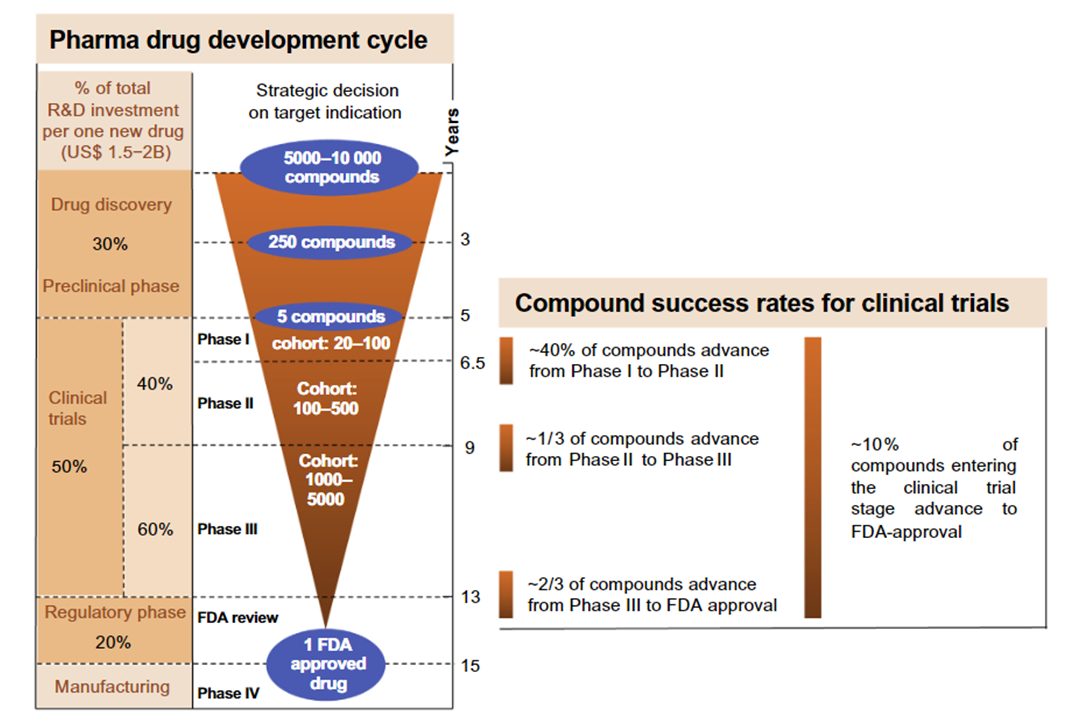
Using more targeted approaches to select more targeted patient populations: genome studies
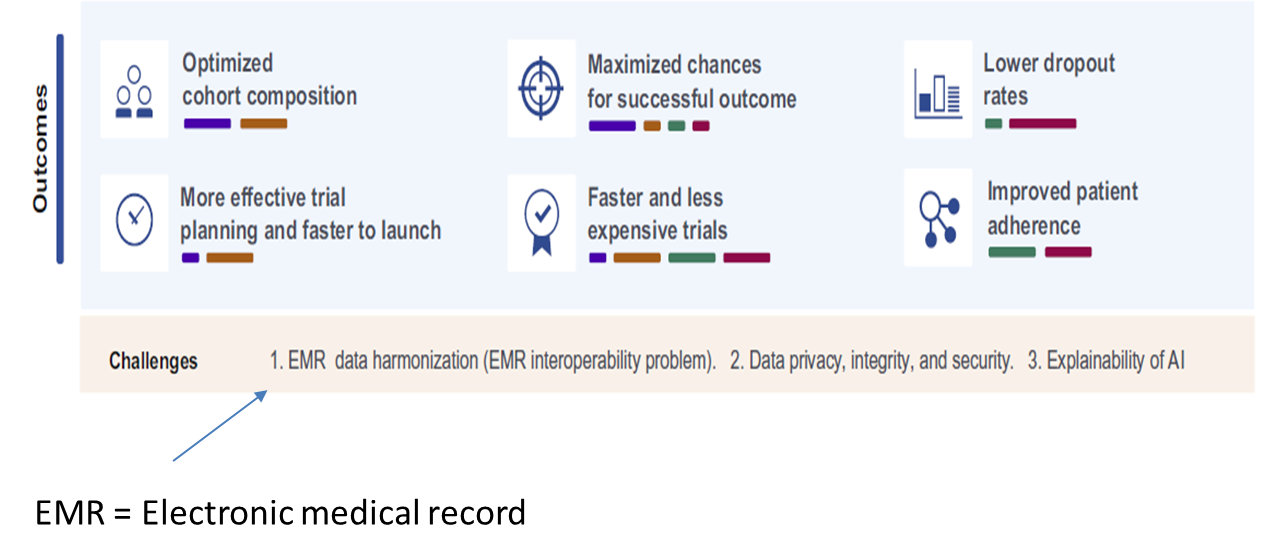
The case of COVID 19- how can the process be speeded up?
Standard protocol of developing a vaccine takes 10 years
Pre COVID19 this was a real challenge.
Answer : Finance and parallel infrastructure development
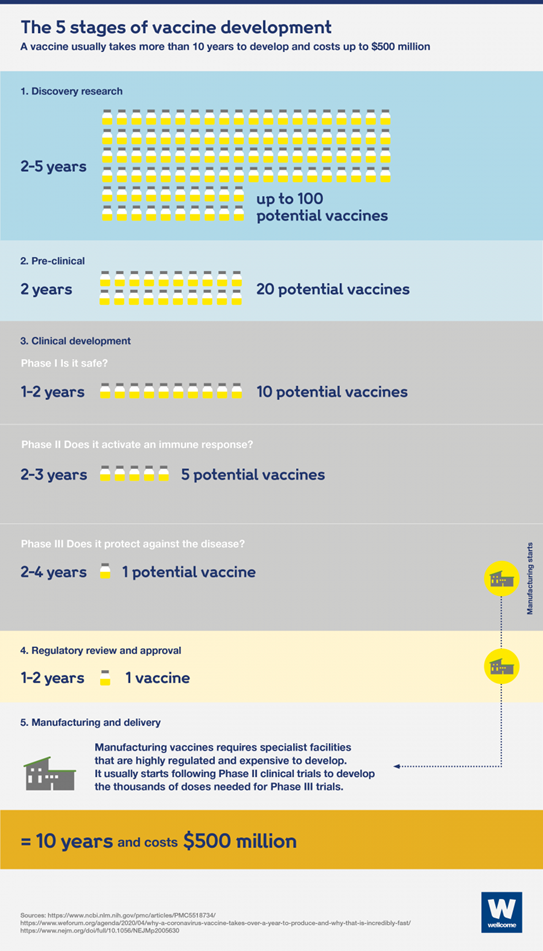
By doing steps simultaneously will dramatically reduce time
Finance was the limiting factor
A fantastic success story for science and should make us better prepared for pandemics in the future
This new tech is being rolled out for many disease- malaria, HIV and cancer
There are 14 vaccines approved and in use, 30 vaccines in stage 3 clinical trials